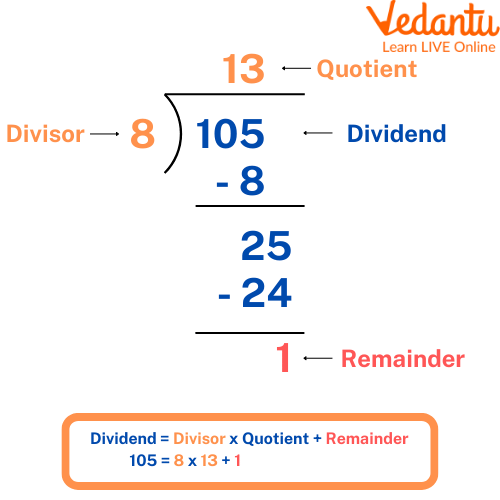




Why Understanding Division Properties Matters in Maths
The division is an arithmetic operation. An arithmetic operation combines two or more numbers using symbols known as arithmetic operators to form the resulting numeric expression. Division can be simply understood as splitting of equal groups of numbers and this rule known as the divide rule in maths. This article is about properties of division. There are many properties of division in mathematics, and this article will talk about them and what they mean. Division can seem like a complicated concept at first, but with an understanding of properties of division of integers, you'll find it much easier!

Division
Divide Rule in Maths
The division is a series of repetitive subtraction done to break down the larger number into smaller numbers, which when multiplied will be equal to the larger number. It is the inverse of the multiplication operation. There are 4 parts of division- The remainder, The Quotient, The Divisor, The Dividend.

Division
The formula to calculate the division of two numbers is: Dividend ÷ Divisor = Quotient + Remainder. Here, The dividend is the number, which is being divided. The divisor is the number, which divides the number (dividend) into equal parts.
What are the Properties of Division?
In mathematics, a property is any characteristic that applies to a given set.
Following are the properties of division of integers:
Property 1: The division of two nonzero integers $a$ and $b$, expressed as $a \div b$ is not necessarily a whole number.
Verification: $a \div b$ gives a quotient that is a whole number $(c)$, then $a=b\times c$. However, in division operations such as $15 \div 2$ there exist no whole numbers whose product with 2 is 15 . Thus, $15 \div 2$ is not a whole number.
Property 2: If a is a nonzero integer, then a divided by the number 1 then the quotient is a.
$a \div 1=a$
Verification: let us take an example
Let $a=5$
$\therefore 5 \div 1=5$
The reason for this is that $5 \times 1=5$
Property 3: If a nonzero number a is divided by itself, the quotient is 1.
$a \div a=1$
Verification: Let's take an example of $3 \div 3=1$ Since $3 \times 1=3\quad \therefore 3 \div 3=1$
Property 4: When 0 is divided by a nonzero number (a), the quotient is 0.
$0 \div a=0$
Verification: Let us assume a=3
$3 \times 0=0 \quad \therefore 0 \div 3=0$
Property 5: If $a, b$, and $c$ are nonzero whole numbers then if $b \times c=a, a \div c=b$, and $a \div b=c$
Verification: Let us take an example
$3 \times 4=12$
$\therefore 12 \div 3=4 \text { and } 12 \div 4=3$
Property 6: Any number divided by 0 is not defined.
$a \div 0$ = not defined.
Verification - Since no number can be divided by 0 to give a valid quotient the answer of this operation is termed as not defined.
Property 7: The Division Algorithm
The division Algorithm states that if a nonzero whole number a (dividend) is divided by a nonzero number b (divisor) then there is a whole number q (quotient) and r (remainder) such that a= bq + r , wherein r = 0 or r < b
Tips and Tricks
When a 2- digit number is divided by 10 then the number in the tens place becomes the Quotient and the number in the one place becomes the remainder
Eg. 32 ÷ 10. Here the quotient is 3 and the remainder is 2
When a number is divided by 100 then the numbers hundreds place becomes the Quotient and the numbers in the ones and tens place become the remainder.
You can check whether your division is correct by applying the division algorithm.
Solved Examples
Q1. Fill in the blanks:
12 ÷ 1 =?
Ans: 12
Explanation- any number divided by 1 gives a quotient equal to the integer itself.
31 ÷ 31=?
Ans: 1
Explanation - any number divided by itself gives the quotient 1.
Q2. State whether the statement is true or false: Zero divided by 6 gives the quotient 0.
Ans: True as zero divided by any nonzero integer is equal to 0.
Practice Problems
Q1. Fill in the blanks
16 ÷ 16 =?
0 ÷ ? = 0
Ans: 1. 16 ÷ 16 = 1
2. Any number
Q2. Choose the correct option; What is the division algorithm
Divisor + Remainder = dividend and quotient
Dividend = Divisor x Quotient + Remainder
Remainder = Dividend x Divisor + Quotient
Ans: 2. Dividend = Divisor x Quotient + Remainder
Summary
In this article, we will be discussing the properties of division of integers. Specifically, we will be looking at the divide rule in maths, what are the properties of division of integers, and examples. As we have seen that the division of two nonzero integers is not necessarily a whole number, if a nonzero integer is divided by 1 then the quotient is the dividend. If a nonzero number is divided by itself the quotient is 1. The quotient of any number divided by 0 is not defined. 0 divided by any number is equal to 0. If a, b, and c are nonzero whole numbers then if $\mathrm{b} \times \mathrm{c}=\mathrm{a}, \mathrm{a} \div \mathrm{c}=\mathrm{b} \text {, and } \mathrm{a} \div \mathrm{b}=\mathrm{c}$. If a nonzero whole number a (dividend) is divided by a nonzero number b (divisor) then there is a whole number q (quotient) and r (remainder) such that a= bq + r , wherein r = 0 or r < b. These are the properties we have learned. We hope that this article was helpful and that you now have a better understanding of what division is and how it works.
FAQs on Properties of Division: Essential Concepts and Examples
1. What are the fundamental properties of division in mathematics?
The fundamental properties of division define how numbers behave in this operation. The key properties are:
- Division by 1: Any number divided by 1 results in the number itself. For example, 15 ÷ 1 = 15.
- Division of a Number by Itself: Any non-zero number divided by itself equals 1. For example, 23 ÷ 23 = 1.
- Division of Zero by a Number: Zero divided by any non-zero number is always zero. For example, 0 ÷ 8 = 0.
- Division by Zero: Dividing any number by 0 is undefined. It is not possible to create groups of zero from a number.
2. What are the four main components of a division problem?
Every division problem consists of four main components that describe the relationship between the numbers involved:
- Dividend: The number that is being divided.
- Divisor: The number by which the dividend is being divided.
- Quotient: The result or answer of the division.
- Remainder: The amount left over after the division is complete. For example, in 17 ÷ 5 = 3 with a remainder of 2, 17 is the dividend, 5 is the divisor, 3 is the quotient, and 2 is the remainder.
3. How does the Division Algorithm property work? Explain with an example.
The Division Algorithm is a core property that formally states the relationship between the four components of division. The formula is: Dividend = (Divisor × Quotient) + Remainder. This property is essential for verifying division results and finding a missing component.
For example, to find the number that when divided by 17 gives a quotient of 5 and a remainder of 13, we use the algorithm:
Dividend = (17 × 5) + 13
Dividend = 85 + 13
Dividend = 98. Thus, the original number is 98.
4. Why is dividing a number by zero considered 'undefined' and not zero?
Dividing a number by zero is undefined because it creates a logical contradiction. Division is the inverse operation of multiplication. For instance, if we say 12 ÷ 4 = 3, it's because 3 × 4 = 12. If we try to calculate 12 ÷ 0, let's assume the answer is 'x'. This would mean x × 0 = 12. However, any number multiplied by zero is always zero, never 12. Since no value of 'x' can satisfy this equation, the operation is logically impossible and therefore classified as 'undefined'. This is different from 0 ÷ 12 = 0, because 0 × 12 = 0 is a true statement.
5. Are the commutative and associative properties applicable to division, like they are for multiplication?
No, division is neither commutative nor associative. This is a key difference from multiplication and addition.
- Not Commutative: The order of numbers cannot be switched. For example, 10 ÷ 2 = 5, but 2 ÷ 10 = 0.2. Since 5 ≠ 0.2, the commutative property does not hold.
- Not Associative: The grouping of numbers cannot be changed. For example, (16 ÷ 4) ÷ 2 = 4 ÷ 2 = 2. However, 16 ÷ (4 ÷ 2) = 16 ÷ 2 = 8. Since 2 ≠ 8, the associative property does not hold.
6. What are some real-world examples that show the importance of understanding division properties?
Understanding the properties of division is crucial for many everyday tasks. Here are some practical examples:
- Budgeting and Finance: Dividing your monthly income to allocate funds for rent, groceries, savings, and bills.
- Cooking and Recipes: Scaling a recipe that serves 8 people down to serve 2 people requires dividing all ingredient amounts by 4.
- Splitting Costs: Fairly dividing a restaurant bill or the cost of a trip among a group of friends.
- Time Management: Calculating how many 30-minute tasks you can complete in a 3-hour window (180 ÷ 30 = 6 tasks).
7. How is the concept of a remainder in division useful for solving practical problems?
The remainder is more than just a leftover; it provides critical information in many scenarios. For instance, it is used for:
- Checking for Divisibility: A remainder of 0 indicates that a number is perfectly divisible by another. This is how we determine if a number is even or odd (dividing by 2).
- Solving Cyclical Pattern Problems: If an event repeats every 7 days, the remainder when dividing the total number of days by 7 tells you which day of the week it will be.
- Grouping and Packaging: If you have 100 items to pack into boxes that hold 12 items each, dividing 100 by 12 gives a quotient of 8 and a remainder of 4. This tells you that you will have 8 full boxes and 4 leftover items.

















